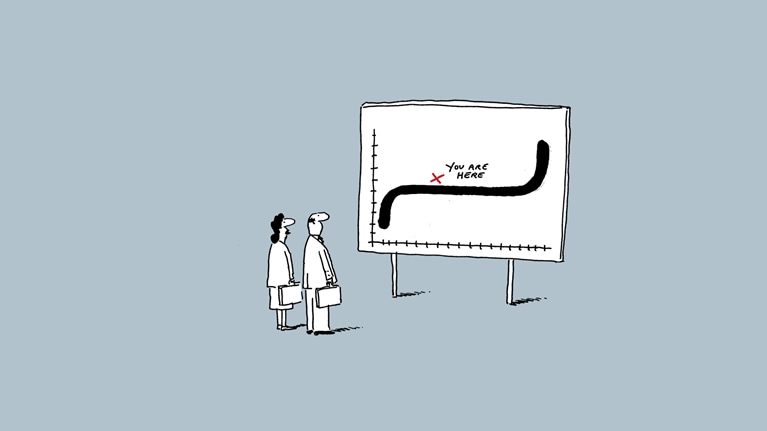Decades of research affirm that programmatic acquisitions deliver better returns than other M&A strategies. In this episode of the Inside the Strategy Room podcast, four experts share insights from their recent article on how to use this M&A approach to weather turbulent times. Senior partner Jeff Rudnicki, a leader in McKinsey’s M&A practice, is joined by Tobias Lundberg, who heads up our M&A services in Europe, and Patrick McCurdy, an M&A specialist based in Boston. They speak with Joanna Stone Herman, a partner at the M&A advisory firm Oaklins DeSilva & Phillips, where she focuses on the technology, media, and telecommunications industries.
This is an edited transcript of their conversation. For more discussions on the strategy issues that matter, follow the series on your preferred podcast platform.
Sean Brown: What is the origin of this research into different M&A strategies?
Jeff Rudnicki: We’ve been looking at how M&A creates value for 24 years. Originally, we wanted to counter the incorrect but widely cited statistic that 70 percent of deals fail. Trillions of dollars are deployed annually on M&A and we knew that statement wasn’t true, so we set out to prove it. Then, when the COVID-19 pandemic hit, we asked, “How does M&A differ during downturns or periods of uncertainty from other times?”
Our research divides the 2,000 largest public companies across the world into four M&A categories. The first is programmatic M&A. These are companies that do more than two deals per year over a decade, acquiring a meaningful amount of market capitalization in the process. Selective acquirers employ a similar strategy of doing small and midsize deals but at a lower frequency. Large-deal acquirers are companies that do at least one large deal, defined as an acquisition representing 30 percent or more of their market cap. Lastly, organic companies effectively do not engage in M&A.
Sean Brown: What does this year’s update on the research show?
Jeff Rudnicki: We do this research every two to three years, and for the fifth time, the results show that programmatic M&A delivers the most value as measured by TSR. Programmatic acquirers, on average, outperform their peer set by 2.3 percent annually and their standard deviation on performance is the smallest. In contrast, companies that grow organically—the group with the lowest returns—underperform their peers by 1.6 percent on average (exhibit). In other words, if your sector TSR grew by 5 percent over a ten-year period, the average programmatic company would increase its share price by 7.3 percent while an organic company would raise its share price by only 3.4 percent. Compounded over ten years, a programmatic company would have a 50 percent higher share price than its average peer.

I’ll note that the average performance of large deals used to be quite negative, and our research suggests this is where the 70 percent figure comes from. That’s no longer the case. These deals are more or less a coin flip, and the best way to make a large deal less risky is to augment or complement it with programmatic M&A.
Sean Brown: Does a similar pattern hold true for divesting in terms of deal size and frequency?
Jeff Rudnicki: Companies that programmatically divest noncore assets also do better and with a lower standard deviation in performance than their peers. Organizations that make large deals and use them as catalysts to sell not only noncore parts of what they acquired but other noncore assets also do well. Those large deals are great opportunities to set your go-forward portfolio.
The big caveat is that divestiture data is messier because when a company acquires, there is a real strategic intent: “I wanted to buy this company.” When a company divests, there are many possible reasons for that move. It may be strategic, because the asset no longer feels core, but the divestiture could also be due to the company having exhausted the asset or facing regulatory pressure to divest in order to secure an acquisition.
Joanna Stone Herman: It’s interesting to me that when a private equity firm sells a company, everybody celebrates. In the corporate environment, a divestiture comes with a sense of failure. That needs to change if you’re going to have a successful programmatic M&A strategy. Just as in R&D, you need to make many bets in M&A. Sometimes they don’t work out as you thought, but good things may still come from them: you acquire a great executive or a new solution that you can integrate into a product. When your strategy shifts, that business may make more sense somewhere else, and you cannot be afraid to make those divestitures. If you hold on to and invest resources into an asset that’s not part of your core strategy, that’s problematic.
Tobias Lundberg: I would add that it’s not surprising that companies active in acquiring and divesting perform better. We see that more broadly in portfolio strategies: companies need to have a certain refresh rate and not just peanut butter the same amount of resources on the same divisions. You should move resources—capital spending, R&D, and also M&A funds—to where there is growth and where those investments accrue value. That’s true also in the inorganic context.
Sean Brown: One aspect of your research is how conditions for M&A and patterns of dealmaking change during downturns. What did you find?
Patrick McCurdy: The first thing we found was that the percentage of deals that are noncash or not all cash tends to tick up. That’s an interesting trend, because while business leaders may not be willing to make acquisitions during downturns, there are often opportunities for partnerships, alliances, or joint ventures from which they can get similar outcomes. The second observation is that the competition from private equity or financial sponsors decreases. We also see that valuations tend to decline as economic activity declines, but the valuation decline lags the economic downturn. Another interesting observation is that in previous cycles, the amount of leverage or debt used for acquisitions tended to increase during downturns. We think that might be different this time.
Sean Brown: Do you see other differences in the recent decline in M&A activity compared to earlier downturns?
Tobias Lundberg: Typically, on the back of a crisis like we had with the pandemic, we see valuations drop. That’s been different this time around. We had a bit of re-rating starting in December and January of last year, which came before the big inflation and interest rate surges. What that means for M&A is still unclear, but some of my clients say they find it harder to settle on a clearing price.
When a private equity firm sells a company, everybody celebrates. In the corporate environment, a divestiture comes with a sense of failure. That needs to change if you’re going to have a successful programmatic M&A strategy.
A second difference is the leverage element. We had low inflation and interest rates for 20 years, with few exceptions. Now, we are clearly in a very different environment and the conversation we’re having with clients is about how to make the investment pay off when cost of capital has risen. You need to be more ambitious on value capture and synergies, and more creative in structuring deals, using JVs [joint ventures], alliances, and minority stakes to get deals done. It also means that some highly leveraged acquisitions will be more difficult, and we see that particularly in the private equity space where some deals are being put off.
One reason for optimism in this economic cycle is that typically, M&A declines lag economic downturns, but today we have, by some accounts, $2 trillion of dry powder sitting on the sidelines. Companies and financial sponsors are waiting for the moment to start deploying it, so it’s possible that we will see more deals being done toward the back end of this year or later.
Sean Brown: Are you seeing any differences in how this M&A downturn is affecting various sectors and regions?
Tobias Lundberg: One thing that’s different now is the pricing pressure squeezing consumers, so any business with a consumer element is affected. The second unique dynamic is the relative resilience of the energy sector, and the third is around ESG [environmental, social, and governance] issues and green tech, with significant money being put to work there by both governments and corporations.
Joanna Stone Herman: The landscape of where deals are happening is also different. Two years ago, we had high demand from China, and because of regulatory changes, that has completely dried up. On the tech side, some hot companies unfortunately had their technology teams in Ukraine. The economic turmoil is feeding into where some of the M&A activity is going.
Jeff Rudnicki: I agree with Joanna. I see companies reevaluating their corporate strategies and then, by implication, their M&A strategies with the impact of geopolitical shifts on different markets in mind. That also leads to potential shifts in due diligence topics and deeper diligence on the resilience of supply chains.
Sean Brown: What do companies need to do to excel at programmatic M&A, and how do the best acquirers build that muscle?
Patrick McCurdy: To develop that muscle, you need to think about M&A holistically, starting with a link to the strategy. When you look at the amount of capital that flows through M&A—over $5 trillion in 2021—and the research showing that programmatic M&A creates excess value, one has to ask, “Why don’t companies invest more in developing M&A capabilities in the same way they invest in innovation, commercial execution, or finance?” You need to be able to source targets, have a good reputation in the market, know how to run a diligence process effectively, and understand how to structure the integration so you maximize value and minimize risk.
Tobias Lundberg: It’s as if you’re training for a sport. The more deals you do, the better you will be at due diligence, at understanding how to gauge your board’s decision gates and knowing whom to pull in from the organization to support the integration.
Sean Brown: How specifically does programmatic M&A help companies become more resilient?
Jeff Rudnicki: When we looked at downturns, we found that programmatic companies had the confidence to do deals despite market turbulence. Programmatic acquirers are 14 percent of the 2,000 global companies, but on average they are responsible for 28 percent of all deal value. During the financial crisis, however, they represented roughly half of all deals. When others lack confidence to make transactions because of exogenous shocks, the best acquirers are doubling down.
And these companies deliver results. During the financial crisis and the pandemic, they outperformed through the downturns and then accelerated during the recovery. They used the period of uncertainty and turbulence to adjust their strategies and portfolios and emerged stronger. These companies used a through-cycle approach to programmatic M&A to position their portfolios to win as conditions improved. Ultimately, we find that the best companies at creating value are also the best at M&A.
Subscribe to the Inside the Strategy Room podcast
Sean Brown: Do you find any unique characteristics or practices among these companies with the through-cycle approach to M&A?
Patrick McCurdy: Early in 2020, when the world was shutting down around us, we stepped back to ask, “Which companies were able to execute their M&A strategies with this through-cycle mindset, and what were their common attributes?” We came up with what we call the three Cs: competitive advantage, conviction, and capacity.
Competitive advantage means being able to quickly reassess how well your strategy holds up in light of exogenous factors that may be reining you in. “What’s different about this moment, and how does that impact our competitive advantage? Therefore, how might it impact our M&A strategy?” The answer might be “not at all,” or it might be “significantly.”
On capacity, we consider financial capacity and also organizational capacity—“How much dry powder do you have and is it ready to deploy? Do you have the capabilities to execute on a programmatic strategy?” We know, for example, that many organizations are going through transformation-type programs these days as they tighten their belts for a possible downturn. If your organization is already undergoing a lot of change, do you have the organizational capacity to take on a series of deals?
On conviction, it’s as simple as asking yourself, “If each member of the management team and the board was asked what the M&A strategy is, would we get consistent answers?” It should be clear, starting at the top and permeating down throughout the organization, how M&A supports the delivery of your strategy. You need that clarity so the people working on due diligence and later integrations understand how the pieces fit together.
Sean Brown: On the point about conviction, can you elaborate on what makes this alignment so important?
Jeff Rudnicki: Let me talk about that through the lens of Joanna’s former job as a strategy or corporate development leader. You find a target. You may cultivate that target for many years. You start to fall in love with the deal’s potential. You bring it to your executive team and your board. Then, instead of debating the merits of buying the target, you end up debating the strategy. You’re unable to act fast or with conviction due to a lack of alignment at the top of the house.
Joanna Stone Herman: I couldn’t agree more. I was fortunate in that I wore both the strategy and corporate development hats for most of my career prior to becoming a banker. That meant I was in charge of figuring out the strategy first and then where M&A would come in. But in many companies, those roles are separate, with different reporting structures.
When others lack confidence to make transactions because of exogenous shocks, the best acquirers are doubling down.
In terms of alignment, one executive aside from the CFO and the CEO who I think should be involved in these conversations is the investment relations officer. Sometimes they are an afterthought, but it’s important that you’re in lockstep so that the quarter before you announce the acquisition, you’re talking about your strategy to investors in a way that will resonate when you come out with the acquisition.
Sean Brown: We have talked about the acquisitions but does the programmatic approach also affect how you do integrations?
Patrick McCurdy: In 2021, when valuations were at record highs, deals being underwritten were fundamentally different from other times. Whereas ten years ago you saw many large, sometimes cost-focused mergers of competitors, two years ago the deals were often growth-focused, relatively small, often programmatic. Therefore, the integrations required a different approach—one less focused on the blocking and tackling of project or integration management and more series of strategy sprints laser-focused on delivering the growth drivers underwritten in the deal. The orchestration revolved around how to sequence these sprints to set the combined company on a path to deliver top-line growth.
Sean Brown: Presumably, the deal rationale also affects the way the integration should be carried out?
Jeff Rudnicki: I do a lot of work in healthcare and biotech, and in these sectors, growth deals are the name of the game. You see multibillion-dollar deals where cost synergies are not unimportant but aren’t even among the top three reasons. In such situations, instead of an integration management office focused on, “How do we put these two companies together?” you need an enablement office to enable that top-line deal model. What is the special sauce in the culture we just acquired? How do we preserve and enhance it? Who are the individuals critical to the top-line acceleration? What are the revenue synergy use cases that integration can’t get in the way of? It’s a very different model than, “There are two boxes and they will become one.”
Sean Brown: Should companies encourage business unit leaders to pursue programmatic M&A opportunities?
Jeff Rudnicki: First, ask yourself which business areas need M&A. Some may have plenty of internal opportunities and a clear growth path, so management may not look for M&A there. In two or three other areas, however, top leaders may believe M&A is critical. The business unit leader could then play a vital role in identifying targets, cultivating those opportunities, and being a partner to the business development leader. Some clients put incentives in those individuals’ performance targets so that if M&A is a meaningful part of their jobs, they are compensated on helping to execute it.
Joanna Stone Herman: At one company I worked for, we allowed business unit leaders to take some non-organic revenue into their targets. That obviously has a huge impact on your excitement about M&A and also lets you see that you are growing your platform. It’s easy to be heads down and say, “I’m fighting the competition.” Well, it might be better to acquire that competitor. Or you may say, “I need to move into this adjacent market”—but it might make more sense to see who is doing well in that market and acquire them. No conversation about growth should be without a discussion of the role M&A could play. Could you go it faster? Could you do it better? Could you fill an important role through an acquisition? Some of the best executives at companies that do programmatic M&A come through acquisitions.
Sean Brown: Do you find that most companies adapt their M&A strategies to the macroeconomic environment?
Joanna Stone Herman is a partner at the M&A advisory firm Oaklins DeSilva & Phillips. Sean Brown is global director of communications for the Strategy and Corporate Finance Practice and is based in McKinsey’s Boston office, where Patrick McCurdy is a partner and Jeff Rudnicki is a senior partner; and Tobias Lundberg is a partner in the Stockholm office.


